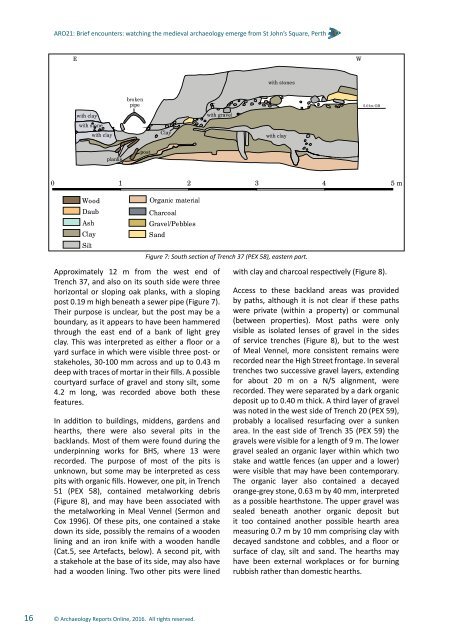medieval archaeology emerge from St John’s Square Perth
ARO21_St_Johns_Square
ARO21_St_Johns_Square
Create successful ePaper yourself
Turn your PDF publications into a flip-book with our unique Google optimized e-Paper software.
ARO21: Brief encounters: watching the <strong>medieval</strong> <strong>archaeology</strong> <strong>emerge</strong> <strong>from</strong> <strong>St</strong> <strong>John’s</strong> <strong>Square</strong>, <strong>Perth</strong><br />
E<br />
W<br />
with stones<br />
with clay<br />
with 2stone<br />
with clay<br />
broken<br />
pipe<br />
Clay<br />
with gravel<br />
with clay<br />
5.01m OD<br />
planks<br />
post<br />
0 1 2 3 4 5 m<br />
Wood<br />
Daub<br />
Ash<br />
Clay<br />
Silt<br />
Organic material<br />
Charcoal<br />
Gravel/Pebbles<br />
Sand<br />
Figure 7: South section of Trench 37 (PEX 58), eastern part.<br />
Approximately 12 m <strong>from</strong> the west end of<br />
Trench 37, and also on its south side were three<br />
horizontal or sloping oak planks, with a sloping<br />
post 0.19 m high beneath a sewer pipe (Figure 7).<br />
Their purpose is unclear, but the post may be a<br />
boundary, as it appears to have been hammered<br />
through the east end of a bank of light grey<br />
clay. This was interpreted as either a floor or a<br />
yard surface in which were visible three post- or<br />
stakeholes, 30-100 mm across and up to 0.43 m<br />
deep with traces of mortar in their fills. A possible<br />
courtyard surface of gravel and stony silt, some<br />
4.2 m long, was recorded above both these<br />
features.<br />
In addition to buildings, middens, gardens and<br />
hearths, there were also several pits in the<br />
backlands. Most of them were found during the<br />
underpinning works for BHS, where 13 were<br />
recorded. The purpose of most of the pits is<br />
unknown, but some may be interpreted as cess<br />
pits with organic fills. However, one pit, in Trench<br />
51 (PEX 58), contained metalworking debris<br />
(Figure 8), and may have been associated with<br />
the metalworking in Meal Vennel (Sermon and<br />
Cox 1996). Of these pits, one contained a stake<br />
down its side, possibly the remains of a wooden<br />
lining and an iron knife with a wooden handle<br />
(Cat.5, see Artefacts, below). A second pit, with<br />
a stakehole at the base of its side, may also have<br />
had a wooden lining. Two other pits were lined<br />
with clay and charcoal respectively (Figure 8).<br />
Access to these backland areas was provided<br />
by paths, although it is not clear if these paths<br />
were private (within a property) or communal<br />
(between properties). Most paths were only<br />
visible as isolated lenses of gravel in the sides<br />
of service trenches (Figure 8), but to the west<br />
of Meal Vennel, more consistent remains were<br />
recorded near the High <strong>St</strong>reet frontage. In several<br />
trenches two successive gravel layers, extending<br />
for about 20 m on a N/S alignment, were<br />
recorded. They were separated by a dark organic<br />
deposit up to 0.40 m thick. A third layer of gravel<br />
was noted in the west side of Trench 20 (PEX 59),<br />
probably a localised resurfacing over a sunken<br />
area. In the east side of Trench 35 (PEX 59) the<br />
gravels were visible for a length of 9 m. The lower<br />
gravel sealed an organic layer within which two<br />
stake and wattle fences (an upper and a lower)<br />
were visible that may have been contemporary.<br />
The organic layer also contained a decayed<br />
orange-grey stone, 0.63 m by 40 mm, interpreted<br />
as a possible hearthstone. The upper gravel was<br />
sealed beneath another organic deposit but<br />
it too contained another possible hearth area<br />
measuring 0.7 m by 10 mm comprising clay with<br />
decayed sandstone and cobbles, and a floor or<br />
surface of clay, silt and sand. The hearths may<br />
have been external workplaces or for burning<br />
rubbish rather than domestic hearths.<br />
16<br />
© Archaeology Reports Online, 2016. All rights reserved.


